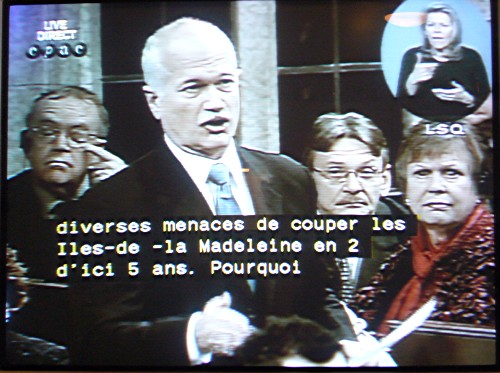No one noticed the other week when French captioning began being transmitted on Question Period in the House of Commons.
It’s been discussed for about a decade. Where was it all this time? Unavailable due to persistent lies propagated by French-language broadcasters – that real-time captioning in French was impossible, or practically so, or was so limited in capacity that only a few shows could be captioned. This has been false since at least 1994; the short version of the truth is that there are not one but two French different adaptations of English stenocaptioning equipment. French broadcasters pretended there were only one such adaptation with almost no trained writers. And – surely by coincidence – no new writers were being trained.
I have demolished these intentional falsehoods and the subterfuge and undermining of French broadcasters in many places, including a response to a Canadian Human Rights Commission report on French captioning.
The standard response in recent years has been a Canadian favourite – buying into a vapourware technology. This time it’s speaker-dependent voice recognition, invariably and falsely described merely as voice recognition. The system is not listening to the audio and spitting out words. A trained human respeaker is doing that, while also pressing keys and otherwise operating a software interface. The system understands only that person’s voice.
The main proponent of this concept is the recipient of many government and related grants, CRIM, whose leaders show a lot of gall in other respects. (I’ve provided comments on their published research on occasion, only to be greeted with hostile and defensive responses or none at all. I note their commitment to scholarship and the scientific method.)
Anyway, I’ve been watching the Question Period captioning (available on either CPAC feed on CC3) and at best it is barely ready for broadcast.
-
Only members of Parliament are captioned. The Speaker never is (in my experience – perhaps an extended address by the Speaker would be).
-
They leave out riding names. This is admittedly a huge complication, one that’s readily handled by traditional stenocaptioning. (You post all of them on a wall with their briefs, that is, the keystrokes you enter to produce them.) After ten seconds’ thought I came up with a way to handle this using voicewriting, but I presume CRIM will simply apply for another grant to solve the problem.
-
There are too many substantive errors by any estimation, let alone the industry-standard estimation CRIM uses in its research. I’ll limit my discussion to errors that work well in photographs, otherwise I’d be here all day explaining what went wrong.
-
Hyphenated terms always use an errant space.

-
Numbers are handled wrong.

-
Every new sentence has to start on a new line, but doesn’t.
-
Slavish adherence to (misunderstood) French punctuation rules leads captioners to set a space in front of question mark and bang. As there is no nonbreaking space in the Line 21 character set, it’s only a matter of time till punctuation ends up as a widow. (“What’s a widow?”)
-
There is no speaker identification, save for VOIX DE L'INTERPRETE (in caps, no less) on its own line.
-
Now, just how confident are the House of Commons and CRIM in the reliability of this new system? Actions speak louder than captioning: The LSQ interpreter is still shown onscreen.
French-language real-time captioning is not ready for this exacting application, though the intransigent liars of the French broadcasting sector will surely hail it as a triumph.